Introduction
The area of innovation is becoming widely the bedrock of an organization’s success and its continuous improvement, which contributes to the building of new opportunities for any organization (Bessant, Öberg, & Trifilova, 2014). In addition, innovation is one of the cornerstones of continued growth and sustainable competitive advantage in large global firms (Doz et al., 2001). Similarly, O’Connor & Euchner (2017) claim that radical innovation is important for any company aiming to maintain dynamic growth. It may be particularly appropriate for companies approaching maturity.
A mature firm is a company that is well-established in its industry, with a well-known product and loyal customer following. Mature firms typically face steady competition and exhibit slow and steady growth (McLaughlin, 2018). In addition, mature companies also tend to pay dividends and can boost profits through cost cuts and efficiency improvements (O’Connor & Ayers, 2017). Recent studies investigated the challenges faced by firms in the sector of mature manufacturing. For instance, Mumford & Hemlin (2017), Jaiswal et al. (2015) claim that there are new challenges that have increased pressure on the global competition with firms across the world. These challenges are related to producing a new generation of competitive products and services. Hence, these firms are starting to link their products and services with thoughts of creativity and innovation to raise their ability into this high competition (Rampa & Agogué, 2021; O’Connor & Ayers, 2017). Although radical innovation is important to business growth, mature organizations are still avoiding it due to the risks associated with it (O’Connor & Euchner, 2017). However, whilst a large proportion of the existing empirical research has concentrated on incremental innovation or innovation management in general, there is little known about the specific aspects of organizational culture that facilitate radical innovation (McLaughlin et al., 2008; Dodge et al., 2017; O’Connor & Euchner, 2017a).
The importance of innovation has been noted by scientists, and research concerning innovation and creativity has garnered much attention from scholars in the last 20–30 years (Lancker et al., 2016) (Uddin et al., 2019). The importance of innovation for firms’ survival and growth is widely acknowledged (Visnjic et al., 2016; de Jong, 2013). However, the relationship between organizational culture and innovation has been subject to different research over the last decade (Naranjo-valencia et al., 2016). Importunely, organizational culture is one of the most important factors to support the ability of mature manufacturing organizations to achieve radical innovation successfully (Bessant, Öberg, & Tri, 2014). In their study, O’Connor & Euchner (2017a) reported that leaders need to focus further on creating a culture of innovation that can lead to the generation of radical innovations. Thus, leaders need to raise their awareness about the increasing impact of leadership and organizational culture on innovation practices (O’Connor & Ayers, 2017; Bessant, Öberg, & Trifilova, 2014). This can be reached by affecting the organization’s culture, within which individual behaviour is manifested (Farson and Keyes, 2002).
According to Hofstede et al. (2010), culture is a powerful human tool for survival, but it is a fragile phenomenon. Consequently, there are so many different meanings and definitions attached to the term culture. The term was first used in this way by the pioneer English Anthropologist Edward B. Tylor in his book, Primitive Culture, published in 1871. Tylor said that culture is “that complex whole which includes knowledge, belief, art, law, morals, custom, and any other capabilities and habits acquired by man as a member of society”. However, there are different layers or levels of culture. For instance, national, group, organizational and individual culture (Karahanna et al., n.d.). In another point of view, McLaughlin (2018) stresses that organizational culture reflects what an organization values: quality, safety, productivity, survival, power, secrecy, justice, humanity and so on. If there are strong values of compassion and safety, new staff learn the importance of caring and safe practice (Edgell et al., 2015; West et al., 2014). In his interesting analysis of culture, Schein (1996) defined organizational culture as a pattern of basic assumptions invented, discovered or developed by a given group as it learns to cope with its problem of external adaptation and internal integration. These values are then taught to new members in the organization as the correct way to think and feel in relation to those problems. For Schein (2016), culture is the sum of all the shared, taken for granted assumptions that a group has learned throughout its history. Also, culture is also the structure and control system to generate behavioral standards (Burnes, 2017). Leaders nowadays need to pay attention to how to go about creating a culture that facilitates innovation practices and that can ultimately lead to the generation of radical innovations (Sarooghi et al., 2015; Rampa & Agogue, 2021). They need to be aware of the fundamental influence of leadership and organisation culture on innovation creation (Dodge et al., 2017b; Bass & Avolio, 1994). The research gap lies in the intersection of these dimensions, and can be expressed as the need to explore the culture of radical innovation in the context of leadership in mature manufacturing organisations. Hence, this research seeks to obtain data which will help to address this research gap.
This study aims to investigate the impact of applying a framework to facilitate radical innovation culture in mature manufacturing organizations. This exploratory study was an initial stage of a research project designed to develop a framework to facilitate a culture of radical innovation in the sector of mature manufacturing organizations. An initial objective of the project was to understand the current situation by identifying the leadership aspects that promote and inhibit radical innovation culture in the mature manufacturing organizations sector. An important extension of this study will more empirically examine multiple dimensions of leadership, organization culture, and radical innovation. This is aiming to understand how these areas relatively can help mature manufacturing organizations to generate a greater culture of radical innovation. Developing such a framework would add great value to mature manufacturing organizations MMO and would also find it useful, which would fill the gap that has been identified in the literature review. According to Weber & Joshi (2000), this can be achieved by answering three crucial questions; first, what is the current culture? Secondly, what is the desired culture? and thirdly, what gaps exist and how they can be bridged?
This study addresses the following questions:
What are the critical successful factors of leadership that can create a culture that enhances radical innovation in mature manufacturing organisations?
How these factors can be applied in mature manufacturing organisations successfully?
Methodology
Understanding the philosophical perspective that underpins the research is essential for selecting the best research design for research initiatives (Broad, 2014; Collins, 2017). However, the purpose of this study is to look into the many components of the use case environment and to see how the culture of the use case environment influences the performance of its top-ranking officers. Because top management teams establish organisational culture based on their histories and personalities (Schein, 2010), research on the impact of founders or leaders on organisational culture has been considerable (Dodge et al., 2017; Schein, 2010).
As the research question of this study concerns the shared meaning of critical success factors of leadership that can create a culture to ultimately enhance radical innovation in mature manufacturing organizations, social constructivism is an appropriate approach as it will shed light on how radical innovation culture is constructed here (Green & Cluley, 2014). Thus, the researcher will “rely as much as possible on the participants’ view of the situation being studied” (Creswell, 2014,p8).
This research employs Schein’s model of organisational culture. Schein’s model (1984) can provide structure for gaining an efficient understanding of the improvement of culture. The author views culture as the insight or empowerment acquired by a group over a period whilst resolving issues or problems concerned with its survival and relevance. In his point of view, Schein indicates that culture is a perceptual structure of underlying assumptions that have been discovered, developed, or improved by a given group as the group learns to cope with its challenges of external adaptation and internal integration (Schein, 2010). In addition, Schein argues that culture is a perceptual structure of underlying assumptions that have been discovered, developed, or improved by a given group as it learns to cope with its challenges of external adaptation and internal integration (Schein, 2016).
A constructive-interpretive philosophical approach, applying a qualitative strategy, is the most appropriate for the present research since it is exploratory and interpretive in nature. According to Sekaran & Bougie (2010, p. 120), “an exploratory study is undertaken when not much is known about the situation at hand, or when no information is available on how similar problems or research issues have been solved in the past”. Similarly, Pidgeon and Henwood (1997) stated that a constructive-interpretive philosophy is likely to contribute most to understanding the subjective interrelationship between researchers and their participants, as well as the construction of meaning.
The interpretive paradigm and grounded theory were found to be useful for this research in enabling the researchers to use individuals’ perceptions and meanings in order to explore, explain and describe what is going on; they enabled the researchers to construct a theory that was grounded in the data collected (Denti & Hemlin, 2012) (Schein, 1988) (Corbin and Strauss, 2014).
The data collection and analysis were conducted in several stages. These stages were adopted from Braun and Clarke’s model of thematic analysis (2013), which was chosen due to its simplicity, clarity, and popularity. According to Ibrahim (2012), the analysis of qualitative data is dependent upon its interpretation. The following are the steps of the thematic analysis that were conducted in this study.
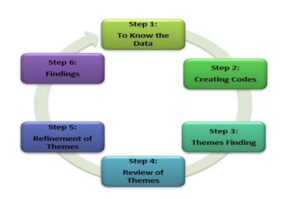
Figure 1 Braun and Clarke’s Model of Thematic Analysis (2006)
The data generated from the interviews were analysed thematically and inductively. This study involved a three-stage analytical approach. Data were collected from a variety of sources over the course of several months during the study process. Theoretical sampling was used throughout the data collection process to determine a certain level of saturation, as shown above in Figure 1. Following the guidelines provided by Binder and Edwards (2010, p. 241), the researcher continued to recruit and interview participants until no fresh data were being generated that offered new information or insights for constructing the theory.
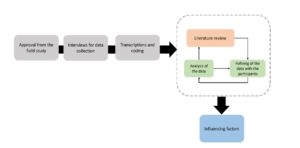
Figure 2: Data collection process
The appropriate method that can help to surface the aspects that control the field study’s performance was to use an issue to encourage the participants to focus their attention on a specific action (Sackmann, 1991). Furthermore, an issue-focus method introduces a specific context that forces participants to draw on their existing knowledge (McLaughlin et al., 2005). This method helped the researcher to identify and understand the aspects that influence the culture of the organisation. A three-stage analytical process was undertaken in this project. Data collected over several months were gathered from multiple sources at various time points during the research process. Throughout the iterative steps in data collection, theoretical sampling was followed to determine a certain level of saturation, as shown above in Figure 2.
The data of this study were collected and then triangulated – semi-structured interviews were checked against the findings from a focus group discussion and direct observation. According to Golafshani (2003, p. 604), “To improve the analysis and understanding of construction by others, triangulation is a step taken by researchers to involve several interpretations of the data by several investigators or peer researchers at different times or locations”. In addition to that, triangulation is needed to ensure the trustworthiness of a study and to identify potential alternate explanations (Lincoln and Guba, 1989).
Methods
A grounded approach was adopted to surfacing the innovation culture characteristics that facilitate radical innovation. The research question was formulated as, “What are The Cultural Enablers and Inhibitors to Radical Innovation in Mature Manufacturing Organizations?”. Adopting grounded theory eased the capturing of the perceptions of the participants in this study (Glaser & Strauss, n.d, 1968.) This study has utilised interviews, informal chats, field notes, journals/magazines, observation to collect the data required. According to Padgett and Deborah (2016), in qualitative research, the potential data come from different sources, such as formal and informal interviews, participant observation and document analysis. Adopting any of these sources will significantly help the researcher, using an inductive approach, to understand the stories people tell, built up from their experiences (Mills et al., 2006b; Denzin and Lincoln, 2017). Qualitative analysis was employed in this study to gain insights into the aspects that dominate the field study (use case domain) practices, as this could help identify and characterise the real situation of phenomena. According to Yin (2013), “a distinctive need for case study research arises out of the desire to understand complex social phenomena”. According to O’Leary (2017), qualitative data are represented through words, pictures or icons and analysed using thematic exploration; quantitative data are represented through numbers and analysed using statistics. Given that the present research into social phenomena is exploratory and interpretative in nature, qualitative methods are, as stated above, the most appropriate for it (O’Leary, 2017; Denzin and Lincoln, 2017; Alvesson and Sköldberg, 2017). To gain a sufficient understanding of the participants’ thinking and their views about leadership, qualitative research is often effective and efficient (Lincoln and Denzin, 1994; Bryman and Bell, 2015). Furthermore, Cassell and Symon (1994), Alvesson and Sköldberg (2017), also suggest that the qualitative method is particularly useful if the research question is related to organisational processes.
The data generated from the interviews have been analysed thematically and inductively.
This study took place in a number of mature manufacturing firms in the United Kingdom as shown in Table 1 below. Before the fieldwork began, ethical clearance was obtained from Cranfield University. Data were collected over several months between February to September 2019, lasting between 40 and 97 minutes each. The researcher designed a pilot study with selected interviewees in a number of mature manufacturing firms in the United Kingdom, as an initial stage of the project.
Table 1 field study details
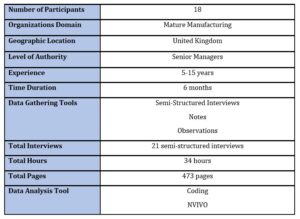
This study was exploratory and interpretative in nature. The data were collected by conducting face-to-face interviews. According to Kvale (2008), an interview tries to elicit and interpret central themes in the lives of the subjects by understanding the meanings of what they say. Similarly, interviews are useful in obtaining the story behind a participant’s experiences and viewpoints of a particular topic and in gathering in-depth information (Turner, 2010). A three-stage analytical process was undertaken in this project.
The key advantage of using semi-structured (face to face) interviewing according to Fontana et al., (1998) is that it provides a suitable channel for collaborating with participants, whilst letting them reveal their opinions about an issue. In addition, it was chosen for this study because it allows a better understanding of the factors that the participants believe play a key role in shaping the current situation (Corbin and Strauss, 1994; Marshall and Rossman, 2006). According to Klein (1996), “one of the chief advantages of face-to-face communication is the ability of the participants to pick up non-verbal cues as the interaction unfolds”. This adds richness to the interpretation of the message as well as communicating the emotional aspects which otherwise might be hidden (Gioia and Sims, 1989).
The researcher interviewed 18 participants from 18 organizations within the targeted sector. The interviews with the research’s participants generated 34 hours of recording and 473 pages of transcription for analysis. Theoretical saturation was reached after 21 interviews, as shown in Table 2 above. The interviews were transcribed and analysed. The researcher then listened to the interviews, double-checked the transcriptions and made any necessary changes to the transcripts. Following this, the researchers uploaded the 21 interviews in Nvivo software (selected as a data management and analysis tool in this project). This qualitative data analysis package was used for coding and facilitated the coding and analytical processes.
Constant comparisons with the literature and the collected data as well as the iterative steps of data collecting from the participants were carried out as shown above in Figure 2. Importantly, the data were recorded on digital audio before being transcribed. The researcher also took field notes during interviews to record initial ideas. To ensure the trustworthiness of the findings and the accuracy of the coding, every response made, whether positive or negative, was considered. In GT, data are analyzed qualitatively, line by line or even word by word, in order to reach the saturation stage of building a theory.
Findings
The collected data are targeted to shape an initial understanding of the context of the project, and hence, address the critical factors and aspects that might influence leadership performance in MMO in the United Kingdom. As a first step, the study asked what aspects encourage or inhibit radical innovation culture in general.
Table 2 below displays the aspects that were obtained from the analysis and description of the data. The findings show the factors that influence the behaviour of leaders in the MMO of the UK and also play a fundamental role in inhibiting and encouraging the development of leadership performance in this sector.
Seventy-one aspects had emerged in this stage of the study; these aspects tend to employ behaviors and different aspects of cognitive, interpersonal qualities of leaders. The domination of these aspects seems to be what affects leaders’ decisions most. It also determines their relationships with subordinates as well as their commitment to the organization.
Table 2: Emerged aspects with their descriptions
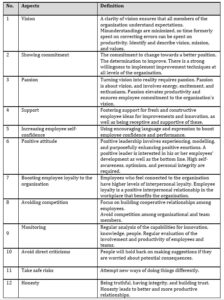
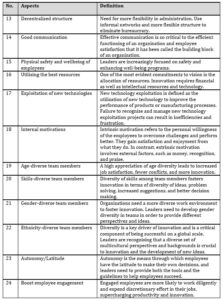
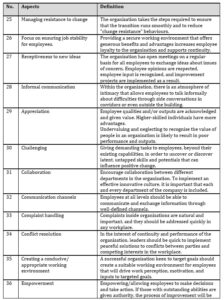
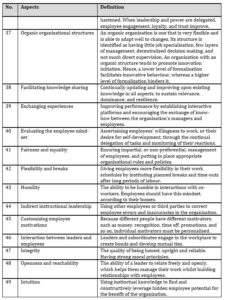

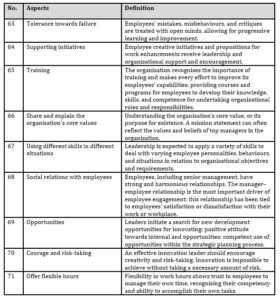
The findings of this exploratory study revealed that various factors influence the radical innovation culture in the mature manufacturing organisations sector, as shown in Table 1. Culture-related factors, in particular, appear to play an important role. The study also discovers that organisational culture and structure have a significant impact on radical innovation. The dominance of these factors appears to be what has the most influence on the decisions made by leaders.
This influences the relationships between leaders and their subordinates, as well as their commitment to the organisation. The findings of this exploration also show that in Table 2 the overall trends it discloses indicate that most of the emerging factors show the characteristics of leadership and organizational culture aspects. However, these aspects tend to employ different behaviours and aspects of a leader’s cognitive, interpersonal qualities. All these qualities play a key role in a leader’s abilities either to inhibit or encourage the innovation and the performance of the organisation to be improved. The dominance of factors, such as supportive administration, positive attitude, communication, rewarding system, risk taking, failure tolerance, latitude, seems to most to affect leaders’ decisions. It also determines their relationships with subordinates as well as their commitment to the organisation. Furthermore, the collected data indicated aspects that are essential in shaping the relationship between leaders and their employees. These aspects are collaboration, arrangement, communication skills and appreciation.
One of the most important benefits of the pilot study was to provide an opportunity to advance understanding of the influences in this field study and assess how far they dominate current performance. Seventy-one open codes emerged from the data, as shown in Table 8. The interviewees indicated that these aspects influence the behaviours of leaders in MMO of the UK. They play a fundamental role in inhibiting and encouraging the development of leadership performance and radical innovation practices in the manufacturing sector in question.
However, most respondents agreed that other factors also play key roles in leadership performance level. These include: Sharing and understanding organization core value, a combination of human-factor and regulation, facilitating knowledge sharing, holding regular social gatherings/ activities, opening communications, personal relationships, personalising the work environment, tolerance with failure, sharing and understanding the organization’s core value and embracing changes, boosting employee devotion and embracing change.
Significantly, this study finds that diversity in age-diverse team members can play a key role in job satisfaction, lower conflicts, and higher innovation. In addition, the diversity of ethnicity-diverse team members has appeared as a key driver of innovation and creativity. According to the study participants, leaders are recognizing that a diverse set of ethnicity, perspectives, and backgrounds, is crucial to innovation and the development of new ideas.
Study findings also suggest a significant influence of factors such as ‘Shared and understand organization core value on; the practices of leaders, the job satisfaction of employees, and the general commitment towards an organisational goal.
Furthermore, the study suggests a general view from participants highlighting the importance of emotional intelligence. Attributes like: being human and honest, showing initiative, having cognitive skills and an eagerness to develop capacity were noted to crucially contribute to the performance of organisations. Some participants expressed the belief that creating a suitable culture and work environment can support daily more comfortable work.
From the perspective of the workforce requirements, this study emphasises the need to give real attention to the important factors to improve performance. These include: encouraging education and supporting skills and personal development – offering on-the-job training for employees during their regular working hours in the same work setting, fairness and equality.
To facilitate the improvement and change process in a workplace, the results of this study emphasise the important role of engaging all staff in change plans and development processes.
Interestingly, one of the most noticeable findings that emerge from this study is the influence of several factors affecting leadership performance in the mature manufacturing sector. For example, aiding employees who have personal issues, individualising employees’ motivation, having moral criteria for employment, using evaluation indicators to assess employees, supervising the relationship between managers and employees in the workplace and evaluating employees’ mind-sets.
The study has also revealed one of the most interesting points of view as “Offer flexible hours”. According to participants, flexibility in work hours shows that you trust your employees to manage their time, recognizing their competency and ability to accomplish their tasks. This relates to daily assignments from the top levels to subordinates as outlined in Table 2 above.
Furthermore, this paper underscores the importance of clear and agreed-upon vision and mission statements, which provide a direction guide to staff as illustrated in Table 2. Monitoring and evaluation also appeared crucial in the process of improving performance development culture.
In investigating the nature of the relationship between leaders and their followers within the workplace, most participants significantly believed in the importance of building a strong relationship through clear and dynamic communication channels. Hence, the study findings suggest a clear connection between designing flexible communication channels and successful change implementation in the workplace.
Discussion
Taken together, these results suggest that there is an association between the findings of this study and the existing research on leader efficiency, typically; Avolio and Gardner (2005) and (Frankel et al., 2007). Both studies discuss the role of organisational context and climate on leadership practices. They also argue that a well-designed organisational context can moderate the style of leadership behaviours. They also suggest that organisations should provide open access to information, resources, and equal opportunity for all employees (O’Connor & Euchner, 2017a).
However, this study produced similar findings to those of Sanghi (2016) who claims that successful organisations need to adopt a flexible organisational structure and improve communication to implement change effectively. Similarly, Yukl (2012) also found that attention should be paid to delegating authority to staff and improving communication channels between managers and staff. In line with this, Nabil et al., (2017) argued that to develop a creative environment, organisations must have a flexible style of structure that ensures a culture that facilitates radical innovation. In line with this, Valencia & Valle (2017) suggested that organisational culture is a key factor for firm innovation and can advance it but also likely represent an obstacle against innovation practices. This is consistent with Conger & Kanungo (1988) who indicated that culture is characterized as having a considerable influence on the propensity of the organization to be accomplished of innovation challenges. This is in line with Vecchio (2007) who stated that culture can determine whether or not the organization is able to survive under changing conditions. This is consistent with Franco et al. (2002) who argued that cultural characteristics can influence the organisational structure decision-making processes within organisations. Moreover, O’Connor & Euchner (2017) indicated that mature manufacturing organisations face challenges to promote a culture that continuously improves the quality of services, innovation, creativity and compassion in this vital sector.
This result overlaps with the thought from Sanghi (2016) stating that organisations need to establish and foster a suitable culture that can enable them to build strong working relationships in the workplace. This can be achieved through aspects such as working closely with the team, ensuring that needs are considered, issues are addressed and situations are managed in a collaborative, consultative, creative, and flexible manner (Sanghi, 2016; Willcocks and Wibberley, 2015). In line with this, Farson and Keyes (2002) and Zentner (2016) argued that leadership practices and cultural aspects have a key influence in the study of invitation. It has also been argued that leadership style plays an essential role in fostering innovation.
One of the most interesting findings of the study suggests that diversity in ethnicity and age-diverse team members can play a key role in job satisfaction and commitment. This is linked with the findings of Mohammadi et al., (2017), Bassett-Jones (2005), who stress that diversity combined with an understanding of individual strengths and weaknesses, and working relationships that are founded upon sensitivity and trust, have been shown to enhance creativity and problem-solving capability (Hennessey & Amabile, 1998). In addition, the ethnic diversity of team members has appeared as a key driver of innovation and creativity. According to the study participants, leaders are recognizing that a diverse set of ethnicity, perspectives, and backgrounds is crucial to innovation and the development of new ideas.
The study found that factors such as tolerance with failure and risk taken in workplace as well as lack of financial rewards appeared dominant among the factors that most affect leaders’ decisions; they also determine leaders’ relations with subordinates as well as their commitment to the organisation. This finding is similar to previous studies which have suggested that leadership can improve innovation by putting a leader who can motivate employees to make initiatives, and tends their fear of making mistakes (Burawat, 2019; Abderraouf et al., 2017). Similarly, previous studies suggested that rewarding entrepreneurship and innovativeness, facilitating risk taking and tolerance of failure encourages idea submission, it creates an environment of formal and informal interdependence and communication which leads to successful innovation (De Brentani & Kleinschmidt, 2004; Colombo et al., 2017).
Significantly, the findings of this study emphasize that diversity can help organizations both lower conflicts, and higher innovation. This is linked with the study of Gomez & Bernet (2019) and Nielsen et al. (2018) whom stress the importance of effects of increasing workplace diversity to facilitate innovation practices. This initial study found that the factors of tolerance with failure and risk taken in workplace appeared dominant among the factors that most affect leaders’ decisions; they also determine leaders’ relations with subordinates as well as their commitment to the organisation. This result is in line with Abderraouf et al. (2017) who found that leadership can improve innovation by putting a leader who can motivate employees to make initiatives, and tends their fear of making mistakes.
The findings of the study also suggest that training for innovation and creativity has been proposed as a means to foster innovation capabilities. This is linked with Rampa & Agogué (2021) who discovered that training for creativity and innovation has a significant influence on developing individual creative skills for exploration, catalysing and federating collective action through common methods and a shared sense of what innovation entails, and assisting in the creation of a common language among the various groups or divisions of an organisation to talk about exploration.
This study produced similar findings to those by Gomez & Bernet (2019) who claim that organisations are willing to experiment and are quick to take advantage of opportunities and complete balanced risk assessments. Similarly, innovative leaders are open to new ideas and emotionally supportive of risk takers (Colombo et al., 2017). Thus, the study suggests that tolerance to failure and risk-taking can enhance willingness and flexibility, ultimately it can create required organisational values and behaviours in order to encourage a culture of radical innovation in this vital sector.
Significantly diversity and Inclusivity is one of the main themes that were found in this study to enhance radical innovation in this sector. This finding supports the work of Gomez & Bernet (2019), who wrote inclusiveness and diversity in the workplace make the employee feel that he is accepted and that he is valued and respected by the company in which he works, which makes him more confident and happier in his work (Mohammadi et al., 2017a). Thus, this finding emphasizes that diversity can help organizations both lower conflicts, and higher innovation. This is in agreement with the findings of Gomez & Bernet (2019) and Nielsen et al. (2018) which highlight the importance of the effects of increasing workplace diversity to facilitate innovation practices. According to Mohammadi et al., (2017a), “the literature on firm innovation has paid limited attention to workforce diversity perspectives, focusing instead on investment decisions, innovation strategies, and external networks” (p. 407). This indicates the key contribution of the emerged diversity and Inclusivity as key theme to enhance radical innovation in MMO in this study.
Conclusion and Implications
This research aimed to achieve an in-depth understanding of the existing practices of leadership in mature manufacturing organizations. This study demonstrates the importance of particular dimensions of leadership behavior and organizational culture on the perceived innovativeness of an organization. This analysis suggests that a clear understanding of the organization’s culture and the role of particular leadership dimensions might help managers create a culture of radical innovation in their organizations. Taken together, these results suggest that there is an association between the findings of this study and the existing research on the linking between leadership practices and organizational culture on the radical innovation in mature manufacturing organizations.
Generally, the study offers some important insights into factors that mainly facilitate radical innovation in mature manufacturing organizations. These include: maintaining personal relationships with employees as a form of personal support, individualising employees’ motivations, having moral criteria for employment, using evaluation indicators to observe and assess employees, supervising the relationship between managers and employees in the workplace, evaluating employees’ mind-set, diversity and combining human factors with regulations.
The identified factors that affect leadership practices in mature manufacturing organizations tend to be those in the behaviours and aspects of cognitive or interpersonal qualities of leaders. A number of elements emerged as important in shaping leadership performance development, such as fairness and equality, risk taking and tolerance with failure, communication. All of these aspects play a key role in a leader’s abilities either to inhibit or encourage performance improvement.
This study is one of the studies designed to assess the impact of leadership practices and culture factors on organizational performance in the sector of mature manufacturing firms to support radical innovation culture. However, an in-depth study on the effectiveness of these factors in isolation can help in addressing the issue of radical innovation culture in mature manufacturing organizations.
References
- Alvesson, M., & Sköldberg, K. (2017). Reflexive Methodology: New Vistas for Qualitative Research – Mats Alvesson, Kaj Sköldberg – Google Books (3rd ed.). SAGE.
- Avolio, B. J., & Bass, B. M. (1995). Individual consideration viewed at multiple levels of analysis: A multi-level framework for examining the diffusion of transformational leadership. The Leadership Quarterly, 6(2), 199–218.
- Avolio, B. J., & Gardner, W. L. (2005). Authentic leadership development: Getting to the root of positive forms of leadership. The Leadership Quarterly, 16, 315–338.
- Bassett-Jones, N. (2005). The Paradox of Diversity Management, Creativity and Innovation. Creativity and Innovation Management, 14(2), 169–175.
- Bessant, J., Öberg, C., & Tri, A. (2014). Industrial Marketing Management Framing problems in radical innovation. 43, 1284–1292.
- Bessant, J., Öberg, C., & Trifilova, A. (2014). Framing problems in radical innovation. Industrial Marketing Management, 43(8), 1284–1292.
- Binder, M., & Edwards, J. S. (2010). Using grounded theory method for theory building in operations management research: a study on inter-firm relationship governance. International Journal of Operations & Production Management, 30(3), 232–259.
- Braun, V., & Clarke, V. (2013). Successful Qualitative Research – Google Books (M. Carmichael (ed.); 2nd ed.). SAGE.
- Broad, C. (2014). Five types of ethical theory. https://api.taylorfrancis.com/content/books/mono/download?identifierName=doi&identifierValue=10.4324/97
- Bryman, A., & Bell, E. (2015). Business research methods. Oxford University Press.
- Burnes, B. (2017). Managing Change – free sample. Managing Change .
- Collins, H. (2017). Creative research : the theory and practice of research for the creative industries. Bloomsbury Publishing.
- Conger, J., & Kanungo, R. (1988). The empowerment process: Integrating theory and practice. Academy of Management Review, 13(3), 471–482.
- Corbin, J., & Strauss, A. (1994). Grounded theory methodology. In L. Denzin, Norman K, Yvonna (Ed.), Handbook of qualitative research. SAGE Publications.
- Creswell, J. C. (2014). __metod__[Creswell,_J.]_Research_design_Qualitative,_Quant(b-ok.xyz) FOURTH ED.
- de Jong, J. P. J. (2013). The decision to exploit opportunities for innovation: A study of high-tech small-business owners. Entrepreneurship: Theory and Practice, 37(2), 281–301.
- Denti, L., & Hemlin, S. (2012). LEADERSHIP AND INNOVATION IN ORGANIZATIONS : A SYSTEMATIC REVIEW OF FACTORS THAT. 16(3), 1–20.
- Denzin, N. K., & Lincoln, Y. S. (2017). The SAGE Handbook of Qualitative Research – Google Books. SAGE.
- Dodge, R., Dwyer, J., Witzeman, S., Neylon, S., & Taylor, S. (2017). The Role of Leadership in Innovation: A quantitative analysis of a large data set examines the relationship between organizational culture, leadership behaviors, and innovativeness. Research Technology Management, 60(3), 22–29.
- Doz, Y., Santos, J., Ubiquity, P. W.-, & 2001, (2001). From global to metanational: How companies win in the knowledge economy. Dl.Acm.Org, 2001(December), 2.
- Edgell, S., Gottfried, H., & Granter, E. (2015). The SAGE handbook of the sociology of work and employment. SAGA.
- Fontana, A., Frey, J. H., Denzin, N. K., & Lincoln, Y. S. (1998). Collecting and interpreting qualitative materials. Interviewing: The Art of Science, 47–78.
- Frankel, A., Gardner, R., Maynard, L., & Kelly, A. (2007). Using the communication and teamwork skills (CATS) assessment to measure health care team performance. The Joint Commission Journal, 33(9).
- Garrido-Franco, M., Ehlert, S., Messerschmidt, A., Marinkovic’, S., Huber, R., Laber, B., Bourenkov, G. P., & Clausen, T. (2002). Structure and function of threonine synthase from yeast. The Journal of Biological Chemistry, 277(14), 12396–12405.
- Gary Yukl. (2012). Leadership in Organizations (8th Edition): Amazon.co.uk: Gary Yukl: 8601404994968: Books. Pearson Education.
- Gioia, D. A., Donnellon, A., & Sims, H. P. (1989). Communication and Cognition in Appraisal: A Tale of Two Paradigms. Organization Studies, 10(4), 503–529.
- Glaser, B. G., & Strauss, A. L. (n.d.). The discovery of grounded theory : strategies for qualitative research.
- Golafshani, N. (2003). Understanding reliability and validity in qualitative research. The Qualitative Report.
- Golafshani, Nahid. (2003). The Qualitative Report Understanding Reliability and Validity in Qualitative Research Understanding Reliability and Validity in Qualitative Research. The Qualitative Report, 8(4), 597–606.
- Gomez, L. E., & Bernet, P. (2019). Diversity improves performance and outcomes. Journal of the National Medical Association, 111(4), 383–392.
- Green, W., & Cluley, R. (2014). The field of radical innovation: Making sense of organizational cultures and radical innovation. Industrial Marketing Management, 43(8), 1343–1350.
- Hennessey, B. A., & Amabile, T. M. (1998). Reality, intrinsic motivation, and creativity. American Psychologist, 53(6), 674–675.
- Hofstede, G., Garibaldi de Hilal, A. V., Malvezzi, S., Tanure, B., & Vinken, H. (2010). Comparing regional cultures within a country: Lessons from Brazil. Journal of Cross-Cultural Psychology, 41(3), 336–352.
- Ibrahim, M. (2012). THEMATIC ANALYSIS: A CRITICAL REVIEW OF ITS PROCESS AND EVALUATION. In West East Journal of Social Sciences-December (Vol. 1, Issue 1).
- Jaiswal, N., management, R. D.-I. journal of hospitality, & 2015, (2015). Transformational leadership, innovation climate, creative self-efficacy and employee creativity: A multilevel study. Elsevier, 51, 30–41.
- Karahanna, E., Evaristo, J., Information, M. S.-J. of G., & 2005, (n.d.). Levels of culture and individual behavior: an investigative perspective. Igi-Global.Com.
- Klein, S. M. (1996). A management communication strategy for change. Journal of Organizational Change Management, 9(2), 32–46.
- Kvale, S. (2008). Qualitative Inquiry between Scientistic Evidentialism, Ethical Subjectivism and the Free Market1:.
- Lancker, J. Van, Mondelaers, K., Wauters, E., & Huylenbroeck, G. Van. (2016). Technovation The Organizational Innovation System : A systemic framework for radical innovation at the organizational level. Technovation, 52–53, 40–50.
- Lincoln, Y. S., & Guba, E. G. (1989). Fourth generation evaluation. Sage.
- Marshall, C., & Rossman, G. B. (2006). Designing qualitative research. Sage Publications.
- McLaughlin, P. (2018). Creating a culture for radical innovation in a small mature business. Proceedings of the Institution of Mechanical Engineers, Part B: Journal of Engineering Manufacture, 232(8), 1471–1483.
- McLaughlin, P., Bessant, J., & Smart, P. (2005). Developing an organizational culture that facilitates radical innovation in a mature small to medium sized company: emergent findings (1826/858).
- McLaughlin, P., Bessant, J., & Smart, P. (2008). Developing an organisation culture to facilitate radical innovation. International Journal of Technology Management, 44(3/4), 298.
- Mohammadi, A., Broström, A., & Franzoni, C. (2017). Workforce Composition and Innovation: How Diversity in Employees’ Ethnic and Educational Backgrounds Facilitates Firm-Level Innovativeness. Journal of Product Innovation Management, 34(4), 406–426.
- Mumford, M., & Hemlin, S. (2017). Handbook of research on leadership and creativity.
- Naranjo-valencia, J. C., Jiménez-jiménez, D., & Sanz-valle, R. (2016). de Psicología Studying the links between organizational culture , innovation , and performance in Spanish companies ଝ. Revista Latinoamericana de Psicología, 48(1), 30–41.
- Nielsen, M. W., Bloch, C. W., & Schiebinger, L. (2018). Making gender diversity work for scientific discovery and innovation. Nature Human Behaviour 2018 2:10, 2(10), 726–734. https://doi.org/10.1038/s41562-018-0433-1
- O’Connor, G. C., & Ayers, A. D. (2017). Building a Radical Innovation Competency. Research-Technology Management, 48(1), 23–31.
- O’Connor, G., & Euchner, J. (2017a). The People Side of Breakthrough Innovation. Research-Technology Management, 60(4), 12–18.
- O’Connor, G., & Euchner, J. (2017b). The People Side of Breakthrough Innovation: An Interview with Gina O’ConnorGina O’Connor talks with Jim Euchner about the people needed to power effective breakthrough innovation inside established companies. Research Technology Management, 60(4), 12–18.
- Padgett, & Deborah K. (2016). Qualitative Methods in Social Work Research – Deborah K. Padgett – Google Books (3rd ed.). SAGE.
- Rampa, R., & Agogué, M. (2021). Developing radical innovation capabilities: Exploring the effects of training employees for creativity and innovation. Creativity and Innovation Management, 30(1), 211–227.
- report, D. T. I.-T. qualitative, & 2010, (2010). Qualitative interview design: A practical guide for novice investigators. Kodu.Ut.Ee, 15, 754–760.
- Sackmann, S. A. (1991). Uncovering culture in organizations. The Journal of Applied Behavioral Science, 27(3), 295–317.
- Sanghi, S. (2016). The Handbook of Competency Mapping : Understanding, Designing and Implementing Competency Models in Organizations. SAGE Publications.
- Sarooghi, H., Libaers, D., & Burkemper, A. (2015). Journal of Business Venturing Examining the relationship between creativity and innovation : A meta-analysis of organizational , cultural , and environmental factors ☆. 30, 2014–2016.
- Schein, E. H. (1988). Manaqement in the 1990s. Technology, November, 52.
- Schein, E. H. (2010). Organizational culture and leadership. Jossey-Bass.
- Schein, E. H. (2016). Organizational culture and leadership. John Wiley & Sons.
- Sekaran, U., & Bougie, R. (2010). Research methods for business : a skill-building approach. Wiley.
- Uddin, M. A., Priyankara, H. P. R., & Mahmood, M. (2019). Does a creative identity encourage innovative behaviour? Evidence from knowledge-intensive IT service firms. European Journal of Innovation Management, 23(5), 877–894.
- Valencia, J. C. N., & Valle, R. S. (2017). Organizational culture and radical innovation : Does innovative behavior mediate this relationship ? June 2016, 407–417.
- Vecchio, R. (2007). Leadership: Understanding the dynamics of power and influence in organizations.
- Visnjic, I., Wiengarten, F., innovation, A. N.-J. of product, & 2016, (2016). Only the brave: Product innovation, service business model innovation, and their impact on performance. Wiley Online Library, 33(1), 36–52.
- Weber, V., & Joshi, M. S. (2000). Effecting and Leading Change in Health Care Organizations. The Joint Commission Journal on Quality Improvement, 26(7), 388–399.
- West, M., Eckert, R., Steward, K., & Pasmore, B. (2014). Developing collective leadership for health care May 2014.
- Willcocks, S. G., & Wibberley, G. (2015). Exploring a shared leadership perspective for NHS doctors. Leadership in Health Services, 28(4), 345–355.
- Yin, R. K. (2013). Case study research : design and methods. SAGE Publications.
- Zentner, A. (2016). Analyzing Failure: A Cornerstone for Growth, Innovation, and Change. SSRN Electronic Journal.
- Zina O’Leary. (2017). The Essential Guide to Doing Your Research Project – Zina O’Leary. SAGE.
- Xie, L. (2019), “Leadership and organizational learning culture: a systematic literature review”, European Journal of Training and Development, Vol. 43 No. 1/2, pp. 76-104











